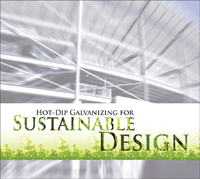Environmental Advantages

Sustainable development (SD) is the social, economic, and environmental commitment to growth and development that meet the needs of the present without compromising the ability of future generations to meet their own needs. As previously stated, finding a sustainable energy source for future generations is a critical issue, and it's not only important to support the green initiatives of mass transit, but also to build sustainable structures to service existing transportation infrastructure. Hot-dip galvanizing can contribute positively to sustainable development initiatives because of its longevity in corrosion protection, maintenance-free service life, 100% recyclability, and minimal environmental impact.
Natural & Recyclable
As previously stated zinc exists naturally in the air, water, and soil and is the 24th most abundant element in the Earth's crust. More than 5.8 million tons of zinc is naturally cycled through the environment by plant and animal life, rainfall, and other natural activity. And zinc is essential for all life; from humans to the smallest microorganisms. Therefore, utilizing hot-dip galvanized steel is not harmful to the environment as the zinc is already naturally found in the area.

In addition to being natural, zinc, like steel, is infinitely recyclable without the loss of any physical or chemical properties. Approximately 30% of the world's zinc supply comes from recycled sources each year, and more would be recycled if it were available. Furthermore, steel is the most recycled material in the world with virtually 100% of structural steel coming from recycled sources, which makes galvanized steel an infinitely renewable material.
Other building materials such as wood and painted steel are less beneficial to the environment. Wood, though a natural material, requires the destruction of fully-mature trees, and though they can be replanted, it takes many years to replace a fully developed tree. On the other hand, utilizing painted steel means introducing man-made chemicals (paint) into the environment through volatile organic compounds (VOCs) and flaking coatings rather than the natural zinc coating of hot-dip galvanizing.
As many mass transit systems are created to support state and city green initiatives, it is important to complement these efforts by choosing a sustainable corrosion protection system utilizing earth-friendly materials.